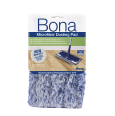Wooden floors have been used in India for centuries, in palaces and places of worship. Since timber has very low thermal conductivity, it is ideal for cold as well as warm climates.
Wooden floors are made out of natural wood and as the name implies, it is made by nature. Even different trees of the same species of timber will have a slightly different colour and grain pattern. So this variation in colour is not a defect but a unique character of wooden flooring.
We would request you to avoid wet mopping. But you can use a damp mop, after wringing out the water well. If you feel that your floor has become dirty, use the Bona Wood Floor Cleaner along with a damp mop and your floor will be spotlessly clean again.
Yes, you need an expert. Read on to understand why.
It is often said that the success of the installation of a wooden floor is determined even before the first piece of wood is laid. The nature of the sub floor, moisture content of the sub floor, the suitability of adhesive for the species of timber selected, need for a moisture barrier, need for a levelling compound, sources of potential moisture migration and preventive measures—these are some of the factors that decide the quality of your floors.
Further, a wooden floor, being an arrangement of many strips of small width, is a complex joinery. These individual strips are prone to moving a little bit, resulting in the floor expanding. This movement will depend on factors like species of timber, width of individual strips and climatic conditions. Based on these factors, one needs to decide how much expansion gap is needed along the edges. Or in the case of a very large room, you probably need to put a slip tongue and start laying the floor in two directions from the centre of the room.
All these calls can only be made by an expert on wooden floors. Do not leave these to the chance of half-baked knowledge of a general purpose contractor.
The entire finishing system we use is Green Guard Certified. This is the highest certification for indoor air quality. Our products are safe even for very young children.( We can give green guard certificate here for Bona products )
A well-installed wooden floor is one of the most durable types of flooring you can have. This might sound counterintuitive when stacked against granite or vitrified tiles. But consider this: a hardwood floor gets its strength from the fibrous nature of the wood. Thanks to this, it can take a good knocking and never cracks or breaks. Moreover, renovating a hardwood floor is comparatively simple and can be done several times. Sand the floor back to the bare wood, apply a coat of finish and presto, you have a new floor! How many types of floors offer you that option?
Some wooden floors do look like that. And they look terrible. This is where the experience of an expert comes into play. When we supply and install a wooden floor for you, we make sure that the timber is suitable for wooden flooring as well as for the climate.
Firstly, timber species used for flooring in other parts of the world may not suit the Indian climate. They tend to move quite a bit, resulting in cracks in the floor (in technical jargon, a timber with a very high co-efficient of expansion for every per cent of change in humidity). This applies to certain temperate timber species and also some tropical species. So the wood needs to be selected wisely.
The second point is the installation of the floor. Was the subfloor assessed properly for strength and moisture? Was the right adhesive used? Several such factors can be the cause of that horrible looking floor. Having expertise and accurate product knowledge is a key factor in getting a good floor, which Westwood has.
Small children running around the house playing is a wonderful memory that most parents will cherish when the kids move out. A wooden floor, in fact, is a perfect one for growing children. They can crawl on the floor, take their baby steps on it and fall a few times—the wood’s shock absorbing nature will ensure they do not get hurt.
As for damages, hardwood floors now come with excellent finishes that can take care of most of the spills and some abuse. In any case, these floors can be completely renovated for a brand new look by a simple sand and re-coat after the children grow up. That way, you will have the best of both worlds.
We at Westwood employ a completely dust-free sanding system, where the sanding is almost 98 per cent dust free. You do not even have to remove the wall curtains or other soft furnishings.
The earlier the better. If we get involved at an early stage, we can help you decide on the levels of the adjacent floors, some inexpensive ways to prevent the chances of moisture migration, help in the preparation of the sub floor and so on. Our technical team has years of experience in wooden flooring installation and we work at hundreds of wooden flooring sites every year. That kind of knowledge can be invaluable in preparing the site for wooden floor.
There
is a big difference qualitatively between a glued down wooden floor and a floor
floating over foam. A glued down wooden floor will give a very solid effect to
the entire floor where as a floating installation will give you a spongy
effect. Further, a glued down wooden floor will also arrest the movement of the
individual strips of wood whereas a floating installation has a higher chance
of popping up in case of any movement due to moisture in the floor.
There are several factors that decide what
method of installation to adopt for your wooden floor.
The width, thickness, and length of the strip
of floor you have selected. Normally we limit the length when we suggest a
glue-down-only installation.
How good
is your subfloor? If we are planning a glue down installation and the subfloor
quality is poor (both in terms of level and smoothness), then we might suggest
a self-levelling compound application. Also, if we are installing a tongue and
groove floor with a ‘glue down to concrete floor’ method, it might be useful to
do a self-levelling compound application.
How much
allowance you have when compared to the adjacent floor is another thing we
consider when we recommend a method of application. If you have very little
allowance, then it might be a good idea to glue down the floor.
What kind
of subfloor you have now is another point to consider? If it is a tile or
marble floor, then removing the tile will be messy, time consuming and
expensive. Then a glue down to tile/marble will be the ideal solution.
As you
can see from the above examples, deciding the method of installation is based
on various factors and we will recommend the best method based on your site
conditions.
An excellent question that normally very few people bother to ask
when they select a wooden floor or when they compare quotes from different
suppliers. Selecting the right adhesive is a very critical factor for the
successful installation of a wooden floor. If you make a mistake here, it could
turn out to be a very expensive one in the long run.
At Westwood,we follow a very strict procedure when selecting the
adhesive for a particular site. It depends on multiple factors: the species of
timber, subfloor, suggested method of installation, moisture conditions at
site, time factor and so on. Normally, the decision on the adhesive is taken by
the most experienced people in our company; it is never a task left to the
juniors in the team.
How will
I know that the subfloor prepared by me /my contractor/builder is suitable for
wooden floor?
%
Get in touch
Gandhi Square, Poonithura
Cochin - 682 038
+91 484 4031559
+91 9995 976 666
info@westwoodfloorings.com
westwoodfloorings.com
Want to work with us? View job openings










689c6fbd0cc62.jpg)
 GREENGUARD Certified products and systems.
GREENGUARD Certified products and systems.
Looking For Wooden Floor Renovation | Westwood Care










689c6fbd0cc62.jpg)

